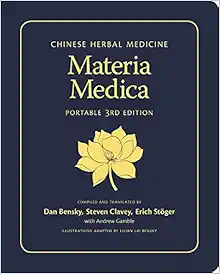
Description
The new 3rd edition of Chinese Herbal Medicine: Materia Medica raises the bar on the practice of herbal medicine in the West. Its commentaries on individual herbs and their combinations provide a wealth of practical information previously unavailable in English. The book is not just informative, it's fun to read. --Charles Chace, L.Ac.I use your book several times each day. It's totally invaluable. Thank you for providing us all with such an indispensable tool. I'm immensely grateful! --Christine Leon, Head, Chinese Medicinal Plants Authentication & Conservation Centre, Royal Botanic Gardens[The 3rd edition] sets a new standard of excellence for Chinese herbals. The level of scholarship in this book is a reminder of what is possible through a combination of intellect, integrity, and hard work. A 'must' for the clinic and the classroom. --Craig Mitchell, L.Ac. From the Inside Flap The new portable edition of Chinese Herbal Medicine: Materia Medica (Portable 3rd Ed.) is designed to provide students and practitioners with the same comprehensive and authoritative content that theyx92ve always relied on, but in a lightweight and more flexible format. The Materia Medica provides a wealth of information and practical insight into more than 530 of the most commonly used herbs in the Chinese pharmacopoeia. Drawing from a wide range of sources, both classical and modern, it provides unparalleled perspective and detail that goes far beyond what is available elsewhere to the Western practitioner. Dan Bensky is a graduate of the Macau Institute of Chinese Medicine (Oriental Medicine Diploma, 1975), University of Michigan (B.A. in Chinese Language and Literature, 1978), Michigan State University College of Osteopathic Medicine (Doctor of Osteopathy, 1982), and the University of Washington (M.A. in Classical Chinese, 1996). He is co-author of the companion volumes Chinese Herbal Medicine: Materia Medica and Chinese Herbal Medicine: Formulas & Strategies, and co-translated and edited Acupuncture: A Comprehensive Text. Dr. Bensky is in private medical practice in Seattle, and is a director of the Seattle Institute of Oriental Medicine. Steve Clavey is a registered Chinese herbalist and has practiced Chinese medicine in Melbourne, Australia since 1986. He studied modern and classical Chinese at the Mandarin Center of Taiwan Normal University, and received his training in Chinese medicine in Taiwan and at the Zhejiang College of TCM in China. He is the author of Fluid Physiology and Pathology in Chinese Medicine, and editor of The Lantern, a new journal of traditional Chinese medicine in Australia. Erich Stöger is a pharmacist and holds Masterx92s degrees in pharmacy (1981) and Chinese studies and anthropology (1990) from the University of Vienna. He studied Chinese at Taiwan Normal University, and since 1989 has translated and published numerous monographs from the Chinese Pharmacopoeia. Since 1990 he has been involved in the identification and analysis of Chinese herbs and extracts for a pharmaceutical laboratory in Germany. He also operates a wholesale Chinese herb business in Austria. Andrew Gamble studied Chinese literature at Taiwan National University (1965-69) and in the Department of East Asian Culture and Linguistics at the University of Munich, where he also taught Chinese linguistics (1969-72). He is a graduate of the New England School of Acupuncture (1977) and studied Chinese medicine at the China Medical College in Taichong, Taiwan (1977-81). He is currently in private practice in Massachusetts and has lectured widely in the United States and Europe on Chinese herbal medicine. Read more
Features & Highlights
- The new portable edition of Chinese Herbal Medicine: Materia Medica (Portable 3rd Ed.) is designed to provide students and practitioners with the same comprehensive and authoritative content that they ve always relied on, but in a lightweight and more flexible format. The Materia Medica provides a wealth of information and practical insight into more than 530 of the most commonly used herbs in the Chinese pharmacopoeia. Drawing from a wide range of sources, both classical and modern, it provides unparalleled perspective and detail that goes far beyond what is available elsewhere to the Western practitioner. Among its many features: Herbs are grouped in chapters by function, with expanded summaries and tables for contrast and comparison. Each herb is identified by its pharmaceutical, pinyin, botanical, and family names, as well as Chinese, Japanese, Korean, and English common names. Key characteristics are provided at the beginning of each entry, along with dosage, properties, channels entered, and relevant cautions and contraindications. This provides a quick overview of essential information. Actions and indications are integrated with important combinations that illustrate the range of an herb s functions, with references to appropriate formulas. This presents a more three-dimensional picture of how each herb is actually used. Expanded commentary offers in-depth analysis and places each herb in its clinical context through rich historical references. The mechanisms of action underlying important combinations, and comparisons with similar herbs, provide a broader context for understanding how the herb can be used with optimal effect. A section devoted to nomenclature and preparation describes the most important methods of processing and preparing each herb, and the advantages of each method. It also provides information about other commonly-used names and historical background. Safety is an important focus of this edition, with an emphasis on proper herb identification. Issues concerning standardized products, desirable qualities, variants, and adulterants are explained for each herb. There is also extensive information on toxicity, as well as chemical constituents. The utility of this book is enhanced by its wide range of appendices, among which are color photographs comparing the standard and adulterant forms of over 20 common herbs; tables of herbs that are indicated for specific pathologies of the five yin organs, and the effects of taste combinations; and extensive cross references of the herbs by taxonomy, pinyin, pharmaceutical name, and other East Asian languages. There are also comprehensive indices of both herbs and formulas, as well as a general index.





